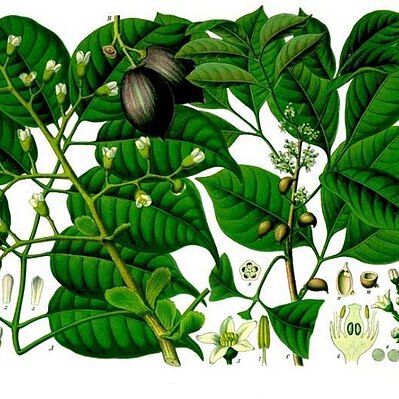Tree up to 35 m by 1 m or more. Branchlets 4-6(-8) mm thick, glabrescent, lenticellate; pith with many peripherally arranged vascular strands. Stipules caducous to subpersistent, inserted on the base of the petiole (up to 5 mm from the branch-let), orbicular, c. 8 mm diam., pubescent. Leaves 3-5-jugate, glabrous. Leaflets lanceolate to oblong, 6.5-25 by 3.5-8.5 cm, subcoriaceous; base equilateral, broadly cuneate to cordate; margin entire; apex gradually, long and broadly, blunt-acuminate; nerves 14-18 pairs (angle c. 65°), straight to slightly curved, gradually to subabruptly arching at some distance from the margin. Inflorescences axillary, together pseudoterminal, paniculate, glabrescent, ♂ ones 10-25 cm long, female ones 5-18 cm; main branches up to 4.5 cm long, in male ones many-flowered, in female ones 3-5-flowered. Flowers subsessile, pubescent, ♂ 2½-4 mm long, female 6-8 mm, with a concave receptacle. Calyx ♂ 1.5 mm high, female 5 mm. Stamens glabrous, ♂ 6-3, free, female 6, slightly connate at the base. Disk ♂ cushion-shaped, flat, solid, 0.5 mm high, densely tomentose; female adnate to the receptacle, with a free rim, glabrous. Pistil ♂ none, ♀ pilose. Infructescences 4-10 cm long, glabrous, with 1-4 fruits; calyx flat, bluntly triangular, 10-12 mm diam. Fruits shortly ovoid to ellipsoid, round to bluntly triangular in cross-section, 2½-3¾ by 1.5-2 cm, glabrous; pyrene smooth; lids c. 2.5 mm thick. Seeds 1(-2); sterile cells small.
More
A large tree. It can grow up to 35 m high and be 1 m through in the trunk. The leaves have 3-5 pairs of opposite leaflets and a leaflet at the end. The leaflets are long or oval and 7-25 cm long by 4-8 cm wide. The leaflets are pointed at the tip and wedge shaped at the base. At the base of the leaf stalk there is a round leafy structure called a stipule. It can be 8 mm across and softly hairy. The small branches are 4-6 mm thick. The flowers are fairly small and borne in large compound flower clusters. The flower clusters occur in the axils of leaves. The male clusters are 10-25 cm long while the female clusters are 5-18 cm long. There are many male flowers in the cluster but 3-5 female flowers in the female clusters. The fruiting stalk can be 4-10 cm long. The fruit is oval and slightly triangular in cross section. Fruit are 2-4 cm long by 1-2 cm wide.
Uses. The timber, which is not very hard, is sometimes used. This tree is the principal source of manila-elemi (see W. H. BROWN Min. Prod. Philip. For. 2 1921 40 VALENZUELA et al. Philip. J. For. 6 1949 54 MANALO & WEST Philip. J. Sc. 78 1950 111 Quis. Med. Pl. Philip. 1951 475 ). The seeds are eaten as pili nuts, though the Main source of these is C. ovatum Engl.
More
The kernels of the nuts are eaten raw or roasted. The fruit pulp can be cooked. Young shoots can be eaten raw.


